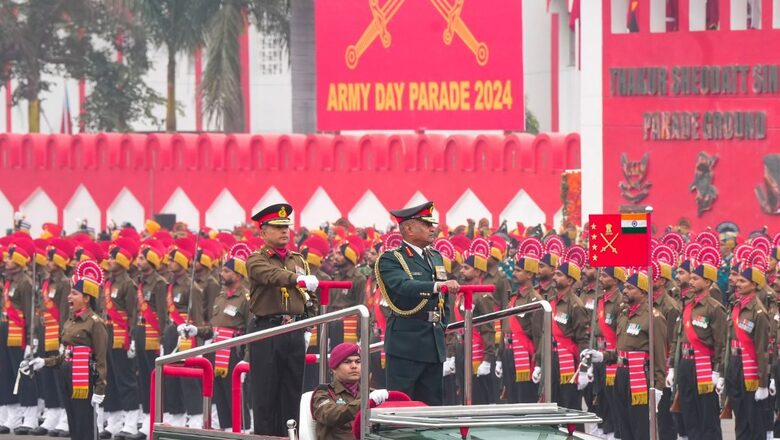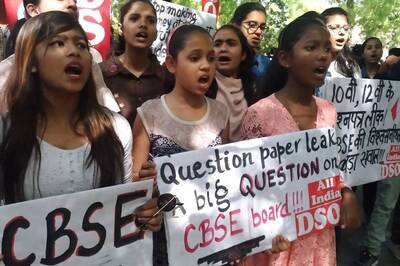
views
India is celebrating the 76th Army Day today, the day that Lieutenant General KM Cariappa took over as Army’s first Indian Commander-in-Chief from British General Francis Roy Bucher in 1949. In the last decade, with around 1.4 million active personnel, the Indian Army has undergone significant transformation with a renewed recruitment policy, an ongoing modernisation drive and a march towards theaterisation.
This time, the Army Day parade was held in Lucknow, marking only the second time that the parade shall be conducted outside of New Delhi. The parade will include six marching contingents, which will be judged with the help of an AI tool, marking the application of new technologies in its workings. In a world of sophisticated drone warfare, and a race for enhanced state-of-the-art cyber warfare capabilities amid a rising threat of the same, the Indian Army has embarked on a modernisation and optimisation drive steered by modernisation of equipment, introduction of new technologies, optimisation of all military functions and financial resources. The Army has also dedicated itself towards doing away with British colonial practices.
There is a shift in the mindset of the top political and military leadership, emphasizing the necessity for a transformation in the armed forces to effectively handle scenarios involving multi-front conflicts. One such concept is the ‘2.5 Front War’, envisioning a coordinated attack by China, Pakistan, and internal adversaries that India must be prepared to counter.
Following 2023, which was designated as the ‘Year of Transformation’, marked by strategic shifts such as the reorientation of artillery, the induction of fresh human resources via Agniveers, and the streamlining of certain sectors with technological advancements, on Army Day, the Indian Army is ushering in 2024 as the ‘Year of Technology Absorption’.
AATMANIRBHAR MODERNISATION SPREE
In the last few years, the Army, leaning towards the idea of Aatmanirbhar Bharat, has embarked on a modernisation drive with the induction of modern equipment and technologies relevant to the changing times. The Army is moving forward with the mantra — ‘Indianise to Modernise’ inducting more and more indigenously-built platforms, and enriching its infantry with state-of-the-art weapon systems, shedding reliance on Soviet-legacy hardware.
The Army is making a deliberate effort to evolve into a modernised force with a novel operational philosophy, focusing on the integration of drones and counter-drone systems across infantry, artillery, and armoured units. Additionally, plans include the establishment of Command Cyber Operations Support Wings (CCOSWs) to address emerging challenges in the cyber domain, along with addressing other conventional disparities.
Further, the structure, shape, and size of India’s fighting forces are poised for significant changes with the introduction of two key measures — the theaterisation process and the Agniveer recruitment system initiated in 2022.
OPTIMISATION THROUGH THEATERISATION
Theaterisation is an ongoing restructuring effort to transition from a division-based structure to theatre commands. India is in the process of setting up three theatre commands involving jointness and integration of the three services— the Army, Air Force and Navy.
In the aftermath of the Kargil War in 1999, the need for theaterisation of command structures was widely recognised. The Kargil Review Committee, led by K Subrahmanyam, recommended a reorganisation of the National Security Framework to enhance the Indian defence system. Acting on this suggestion, the creation of the Chief of Defence Staff (CDS) position was proposed by the Group of Ministers in 2001, with subsequent plans for optimizing the theaterisation of the three services. However, due to a lack of political support and consensus, the decision on establishing the CDS post was delayed. It was only on December 24, 2019, that the Cabinet Committee on Security finally decided to create the CDS position, followed by the appointment of India’s first CDS on December 30, 2019.
Tangible progress toward theaterisation faced challenges until 2020 when the then Chief of Defence Staff, General Bipin Rawat, presented a potential framework for the theatre commands of the Armed Forces. He delineated five potential theatre commands, categorised by geographical and functional criteria: Eastern, Western, Peninsular, Maritime, and Air Defence Commands. Additionally, he suggested two functional commands, namely the Joint Training Command and Operational Logistics Command.
AGILE AGNIVEERS TO DRIVE CHANGE
The Agnipath Scheme, a new human resource recruitment policy, has further revamped the way the Army fills its ranks ensuring a younger age profile of soldiers and enhanced combat potential, and saving on financial resources. Under the Agnipath scheme, which was introduced in 2022, soldiers between the ages of 17 and 21 are recruited every year for a period of four years in the three military services. The Agniveers are not eligible for pensions and are rather released with a corpus amount of over 12 lakh rupees after their term of service. Following their short-term service, 25% of Agniveers shall be inducted for permanent service.
Indian Army Chief General Manoj Pande had recently termed the Agnipath scheme as a “path-breaking manpower and management methodology” which will ensure a youthful profile and bring more technologically adapted soldiers into the ranks and file of the army. He also said that the scheme will ensure the retention of the “best of the best” in permanent service.
MORE ROOM FOR WOMEN
The Indian Army is also working on ensuring inclusivity in its ranks with a gender neutral policy for common promotion of officers’ which would grant women officers equal opportunities alongside their male counterparts to graduate higher ranks. Recently, 120 women officers were promoted to the selection grade rank of colonel. These officers have been deployed under various circumstances in peace stations as well as challenging areas and forward locations. In a sign of greater inclusion of women, the Army is also recruiting women Agniveers in the Corps of Military Police.
The Army is focused on restructuring its organisational formations by right-sizing and rationalising the units and establishments. It is also leaning towards outsourcing non-core functions to optimise its manpower.
Further, the force is actively embracing automation, digitization, and networking at a remarkable pace to enhance procedural efficiency. This reflects the ongoing evolution of the Indian Army.
With military cooperation becoming a major part of India’s relationships with many countries, the Indian armed forces are also part of several joint military exercises, within bilateral and multilateral frameworks, with several foreign militaries, maintaining its growing relevance in strategic and geopolitical equations. The Indian Army is a crucial part of these exercises. A notable one is the Yudh Abyas — a joint exercise with the US Army. The 18th edition of the exercise was held in India, 100 kilometres from the line of actual control (LAC), in Auli, Uttarakhand, where the Indian Army showcased its might in the difficult mountainous terrain and extreme climatic conditions.
The 76th Army Day parade comes at a time when the Indian Army has launched Operation Sarvashakti in Jammu and Kashmir targeting terrorists operating on both sides of the Pir Panjal mountain ranges. It is also locked in a standoff with China at the Line of Actual Control (LAC) for the last four years. The day marks a sharp reminder of India’s independence, valour and zeal to pursue peace and security within its borders and beyond. Facing fast-evolving geopolitical realities, the Indian Army has risen up to the challenge and is diligently laying the brickwork for a futuristic, modern army.


















Comments
0 comment